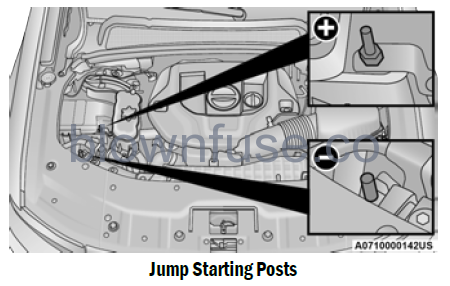2022 Jeep Grand Cherokee Jump Starting User Manual

JUMP STARTING
If your vehicle has a discharged battery, it can be jump-started using a set of jumper cables and a battery in another vehicle, or by using a portable battery booster pack. Jump starting can be dangerous if done improperly, so please follow the procedures in this section carefully.
WARNING!
Do not attempt jump-starting if the battery is frozen. It could rupture or explode and cause personal injury.
CAUTION!
Do not use a portable battery booster pack or any other booster source with a system voltage greater than 12 Volts or damage to the battery, starter motor, alternator or electrical system may occur.
NOTE:
When using a portable battery booster pack, follow the manufacturer’s operating instructions and precautions.
PREPARATIONS FOR JUMP START
The battery in your vehicle is located under the driver’s front seat. There are remote terminals located under the hood to assist in jump-starting.

Remote Positive (+) Post
Remote Negative (-) Post
NOTE:
The remote battery posts are viewed by standing on the right side of the vehicle looking over the fender. The positive battery post may be covered with a protective cap. Lift up on the cap to gain access to the positive battery post. Do not jump off fuses. Only jump directly off the positive post which has a positive (+) symbol on or around the post.
See the following steps to prepare for jump-starting:
- Apply the parking brake, shift the automatic transmission into PARK (P) and turn the ignition OFF.
- Turn off the heater, radio, and all electrical accessories.
- If using another vehicle to jump-start the battery, park the vehicle within the jumper cables’ reach, apply the parking brake and make sure the ignition is OFF.
NOTE:
Be sure that the disconnected cable ends do not touch each other, or either vehicle, until properly connected for jump-starting.
WARNING!
Do not allow vehicles to touch each other as this could establish a ground connection and personal injury could result.
- Take care to avoid the radiator cooling fan whenever the hood is raised. It can start anytime the ignition switch is ON. You can be injured by moving fan blades.
- Remove any metal jewelry such as rings, watch bands, and bracelets that could make an inadvertent electrical contact. You could be seriously injured.
- Batteries contain sulfuric acid that can burn your skin or eyes and generate hydrogen gas which is flammable and explosive. Keep open flames or sparks away from the battery.
JUMP STARTING PROCEDURE
WARNING!
Failure to follow this jump starting procedure could result in personal injury or property damage due to a battery explosion.
CAUTION!
Failure to follow these procedures could result in damage to the charging system of the booster vehicle or the discharged vehicle.
NOTE:
Make sure at all times that unused ends of jumper cables are not contacting each other or either vehicle while making connections.
Connecting The Jumper Cables
- Connect the positive (+) end of the jumper cable to the remote positive (+) post of the discharged vehicle.
- Connect the opposite end of the positive (+) jumper cable to the positive (+) post of the booster battery.
- Connect the negative (-) end of the jumper cable to the negative (-) post of the booster battery.
- Connect the opposite end of the negative (-) jumper cable to the remote negative (-) post (exposed metallic/unpainted post of the discharged vehicle) located directly in front of the underhood fuse box.
WARNING!
Do not connect the jumper cable to the negative (-) post of the discharged battery. The resulting electrical spark could cause the battery to explode and could result in personal injury. - Start the engine in the vehicle that has the booster battery, let the engine idle a few minutes, and then start the engine in the vehicle with the discharged battery.
CAUTION!
Do not run the booster vehicle engine above 2, 000 RPM since it provides no charging benefit, wastes fuel, and can damage the booster vehicle engine. - Once the engine is started, follow the disconnecting procedure below.
Disconnecting The Jumper Cables
- Disconnect the negative (-) end of the jumper cable from the remote negative (-) post of the discharged vehicle.
- Disconnect the opposite end of the negative (-) jumper cable from the negative (-) post of the booster battery.
- Disconnect the positive (+) end of the jumper cable from the positive (+) post of the booster battery.
- Disconnect the opposite end of the positive (+) jumper cable from the remote positive (+) post of the discharged vehicle.
- Reinstall the protective cover over the remote positive (+) post of the discharged vehicle.
If frequent jump-starting is required to start your vehicle have the battery and charging system tested at an authorized dealer.
CAUTION!
Accessories plugged into the vehicle power outlets draw power from the vehicle’s battery, even when not in use (i.e., cellular devices, etc.). Eventually, if plugged in long enough without engine operation, the vehicle’s battery will discharge sufficiently to degrade battery life and/or prevent the engine from starting.

